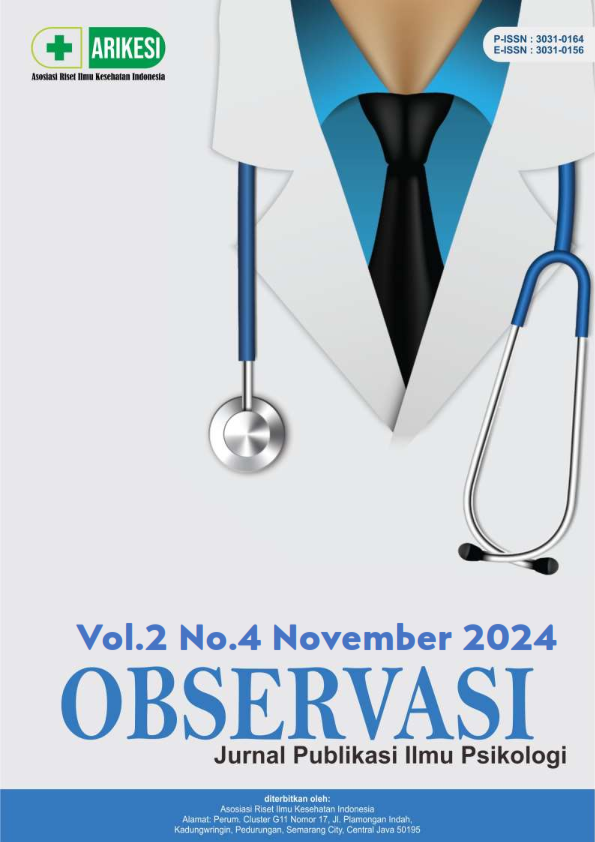Kepemimpinan Transformasional dan Kebahagiaan di Tempat Kerja : Meta-Analisis
DOI:
https://doi.org/10.61132/observasi.v2i4.1078Keywords:
Employees, Transformational Leadership, Workplace HappinessAbstract
This meta-analysis aims to measure the correlation between transformational leadership and workplace happiness by considering the effect size. The number of studies used in this study were 12 studies from 7 literatures that were considered to have met the requirements. The total sample of this study was 2662 people. The results of this meta-analysis indicate that a significant positive correlation between transformational leadership and workplace happiness is found at 95% CI (0.279; 0.612). The relationship between transformational leadership and workplace happiness is included in the moderate category with a score of r = 0.445. Similar results were found in other sample groups, namely the employee group (95% CI [0.234; 0.507]) with a score of r = 0.371. ; the health worker group obtained a score of r = 0.219 with 95% CI [0.142; 0.297]) and in the academic staff group a score of r = 0.565 with 95% CI [0.320; 0.808]). The results of the heterogeneity test showed good results and no publication bias.
Downloads
References
Andrew, S.S. (2011). S.M.I.L.E.S.: The differentiating quotient for happiness at work. Happiest Minds: The Mindful IT Company.
Bass, B.M., & Riggio, R.E. (2006). Transformational leadership (2nd ed.). Lawrence Erlbaum Associates.
Bataineh, K.A. (2019). Impact of work-life balance, happiness at work, on employee performance. International Business Research, 12(2), 99-112. https://doi.org/10.5539/ibr.v12n2p99
Bellet, C.S., DeNeve, J.E., & Ward, G. (2020). Does employee happiness have an impact on productivity? For Online Publication Only.
Borenstein, M., Hedges, L.V., Higgins, J.P.T., & Rothstein, H.R. (2021). Introduction to meta-analysis (2nd ed.). Wiley.
Cassar, V., & Buttigieg, S. (2013). An examination of the relationship between authentic leadership and psychological. International Journal of Humanities and Social Science, 3(5), 171-183.
Chaiprasit, K., & Santidhirakul, O. (2011). Happiness at work of employees in small and medium-sized enterprises, Thailand. International Conference on Asia Pacific Business Innovation & Technology Management, 189-200.
Cohen, J. (1988). Statistical power analysis for the behavioral sciences (2nd ed.). Lawrence Erlbaum Associates.
Diener, E. (2009). The science of well-being: The collected works of Ed Diener. Social Indicators Research Series, 37. https://doi.org/10.1007/978-90-481-2350-6_2
Dursun, I.E., & Bilgivar, O.O. (2022). The effect of school principals’ leadership styles on teacher performance and organizational happiness. International Journal of Educational Administration and Leadership: Theory and Practice, 1(1), 12-25.
Erdogan, B., Bauer, T.N., Truxillo, D.M., & Mansfield, L.R. (2012). Whistle while you work: A review of the life satisfaction literature. Journal of Management, 38(4), 1038-1083. https://doi.org/10.1177/0149206311431192
Fisher, C. (2010). Happiness at work. International Journal of Management Review, 12, 284-412. https://doi.org/10.1111/j.1468-2370.2009.00209.x
Isa, K., Tenah, S.S., Atim, A., & Jam, N.A.M. (2019). Leading happiness: Leadership and happiness at a workplace. International Journal of Recent Technology and Engineering, 8(3), 6551-6553. https://doi.org/10.35940/ijrte.C5299.098319
Kittinorarat, J. (2022). The antecedents of happiness at work and its impact on organizational citizenship behavior among staff in public higher education institutions in Thailand. PSAKU International Journal of Interdisciplinary Research, 11(2), 19-32.
Ling, Y.L., & Kanesan, A.G. (2016). Workplace happiness, transformational leadership, and affective commitment. Paper presented at International Conference on Social Sciences and Humanities (SOSHUM).
Page, M.J., McKenzie, J.E., Bossuyt, P.M., Boutron, I., …, & Moher, D. (2021). The PRISMA 2020 statement: An updated guideline for reporting systematic reviews. BMJ, 372, n71. https://doi.org/10.1136/bmj.n71
Pryce, J., & Lindsay, J.J. (2014). What happiness at work is and how to use it. Industrial and Commercial Training, 46(3), 130-134. https://doi.org/10.1108/ICT-10-2013-0072
Setiawan, R., Eliyana, A., Suryani, T., & Handojo, A. (2020). Maximizing happiness at work: The best practices of transformational leadership at food and beverage start-up businesses in Indonesia. Sys Rev Pharm, 11(12), 1265-1271.
Singh, S., & Aggarwal, Y. (2017). Happiness at work scale: Construction and psychometric validation of a measure using mixed method approach. Journal of Happiness Studies. https://doi.org/10.1007/s10902-017-9882-x
Valina, A.S., Cabrales, A.L., & Fernandez, J.A.R. (2017). On the road to happiness at work (HAW): Transformational leadership and organizational learning capability as drivers of HAW in a healthcare context. Journal of Service Theory and Practice, 27, 292-310. https://doi.org/10.1108/JSTP-07-2016-0141
Vallina, A.S., & Alegre, J. (2018). Happiness at work: Developing a shorter measure. Journal of Management & Organization. https://doi.org/10.1017/jmo.2018.24
Vallina, A.S., Simone, C., & Guerrero, R.F. (2018). The human side of leadership: Inspirational leadership effects on follower characteristics and happiness at work (HAW). Journal of Business Research. https://doi.org/10.1016/j.jbusres.2018.02.027
Downloads
Published
How to Cite
Issue
Section
License
Copyright (c) 2024 Observasi : Jurnal Publikasi Ilmu Psikologi

This work is licensed under a Creative Commons Attribution-ShareAlike 4.0 International License.





